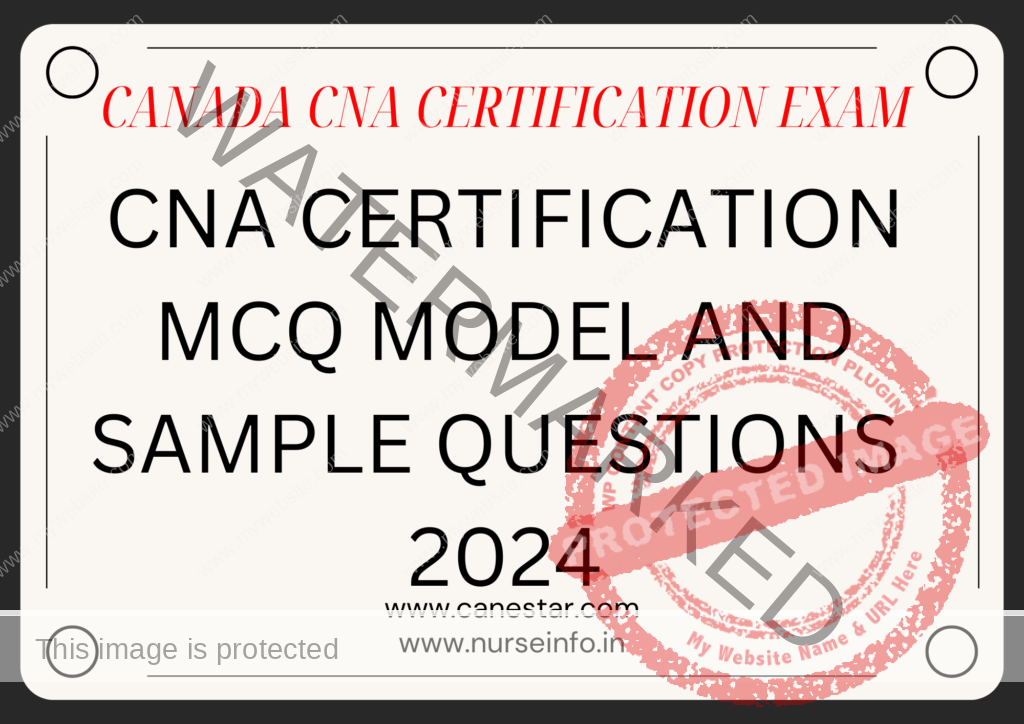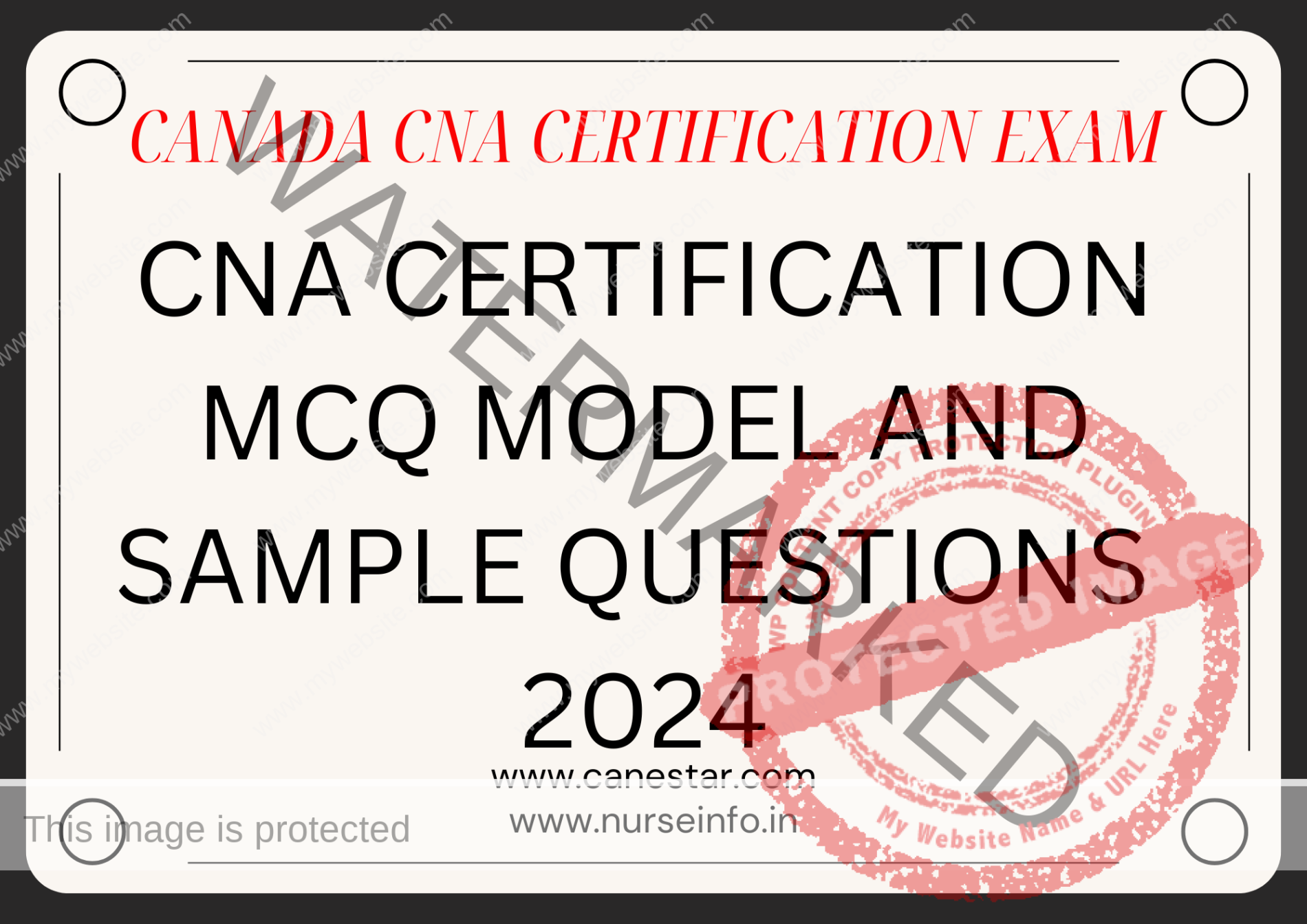CNA CERTIFICATION MCQ MODEL AND SAMPLE QUESTIONS
Question: Which physiological change commonly occurs in the older adult population?
A) Increased lung capacity
B) Decreased bone density
C) Enhanced short-term memory
D) Accelerated wound healing
Answer: B) Decreased bone density
Question: What is a common risk factor for falls in older adults?
A) Increased muscle strength
B) Improved balance and coordination
C) Polypharmacy (multiple medications)
D) Enhanced vision
Answer: C) Polypharmacy (multiple medications)
Question: What is the most prevalent chronic condition among older adults?
A) Type 1 diabetes
B) Hypertension
C) Asthma
D) Osteoarthritis
Answer: B) Hypertension
Question: Which intervention is essential in preventing pressure ulcers in older adults with limited mobility?
A) Encouraging prolonged periods of immobility
B) Providing frequent repositioning and pressure relief
C) Using high-risk surfaces for seating and bedding
D) Applying heat packs directly to bony prominences
Answer: B) Providing frequent repositioning and pressure relief
Question: What is a common psychosocial challenge faced by many older adults?
A) Increased socialization and community engagement
B) Financial stability and security
C) Enhanced family support and caregiving
D) Decline in independence and autonomy
Answer: D) Decline in independence and autonomy
Question: What is the first step in the nursing management of a patient experiencing a medical emergency?
A) Administering medications
B) Performing a comprehensive physical assessment
C) Calling for assistance and initiating emergency response protocols
D) Documenting the patient’s medical history
Answer: C) Calling for assistance and initiating emergency response protocols
Question: What is the priority intervention for a patient experiencing anaphylaxis?
A) Administering epinephrine
B) Starting an IV line
C) Placing the patient in a supine position
D) Checking vital signs
Answer: A) Administering epinephrine
Question: What is the primary goal of cardiopulmonary resuscitation (CPR) in the emergency setting?
A) Restoring normal heart rhythm
B) Providing oxygen to the brain and vital organs
C) Ensuring adequate ventilation
D) Administering medications to stabilize blood pressure
Answer: B) Providing oxygen to the brain and vital organs
Question: What is the appropriate sequence of actions during the initial assessment of a trauma patient?
A) Airway, breathing, circulation, disability, exposure (ABCDE)
B) Circulation, airway, breathing, disability, exposure (CABDE)
C) Breathing, airway, circulation, disability, exposure (BACDE)
D) Disability, airway, breathing, circulation, exposure (DABCE)
Answer: A) Airway, breathing, circulation, disability, exposure (ABCDE)
Question: Which condition requires immediate intervention to prevent further complications?
A) Mild allergic reaction
B) Hypoglycemia with altered mental status
C) Stable angina
D) Minor laceration
Answer: B) Hypoglycemia with altered mental status
Question: What is the priority nursing action when caring for a patient with suspected carbon monoxide poisoning?
A) Administering oxygen therapy
B) Administering activated charcoal
C) Initiating cardiac monitoring
D) Providing pain relief
Answer: A) Administering oxygen therapy
Question: Which assessment finding indicates a potential complication of a chest tube insertion?
A) Continuous bubbling in the water seal chamber
B) Absence of fluctuation in the water seal chamber
C) Increased drainage output over time
D) Subcutaneous emphysema around the insertion site
Answer: D) Subcutaneous emphysema around the insertion site
Question: What is the primary nursing intervention for a patient with suspected poisoning?
A) Administering ipecac syrup to induce vomiting
B) Administering activated charcoal
C) Initiating IV fluids
D) Administering a sedative to calm the patient
Answer: B) Administering activated charcoal
Question: What is the primary purpose of the Rapid Response Team (RRT) in the hospital setting?
A) To provide routine nursing care
B) To initiate early interventions for deteriorating patients outside the ICU
C) To manage administrative tasks
D) To conduct routine patient rounds
Answer: B) To initiate early interventions for deteriorating patients outside the ICU
Question: What is the priority nursing action when caring for a patient experiencing a seizure?
A) Placing a padded tongue blade in the patient’s mouth
B) Restraining the patient to prevent injury
C) Protecting the patient from injury by moving nearby objects
D) Administering a sedative to stop the seizure activity
Answer: C) Protecting the patient from injury by moving nearby objects
Question: Which laboratory test is used to assess kidney function?
A) Serum potassium
B) Serum creatinine
C) Serum albumin
D) Serum sodium
Answer: B) Serum creatinine
Question: What is the primary purpose of hemodialysis in patients with end-stage renal disease (ESRD)?
A) To restore kidney function
B) To remove waste products and excess fluid from the blood
C) To prevent urinary tract infections
D) To decrease serum calcium levels
Answer: B) To remove waste products and excess fluid from the blood
Question: Which dietary restriction is commonly recommended for patients with chronic kidney disease (CKD)?
A) Low protein intake
B) High sodium intake
C) High potassium intake
D) High phosphorus intake
Answer: A) Low protein intake
Question: What is the priority nursing intervention for a patient receiving peritoneal dialysis who develops signs of peritonitis?
A) Administering antibiotics
B) Increasing the dialysate flow rate
C) Removing the peritoneal catheter
D) Providing pain relief
Answer: A) Administering antibiotics
Question: Which complication is associated with long-term hemodialysis treatment?
A) Hypokalemia
B) Hypotension
C) Hypernatremia
D) Arteriovenous fistula (AVF) stenosis
Answer: D) Arteriovenous fistula (AVF) stenosis


